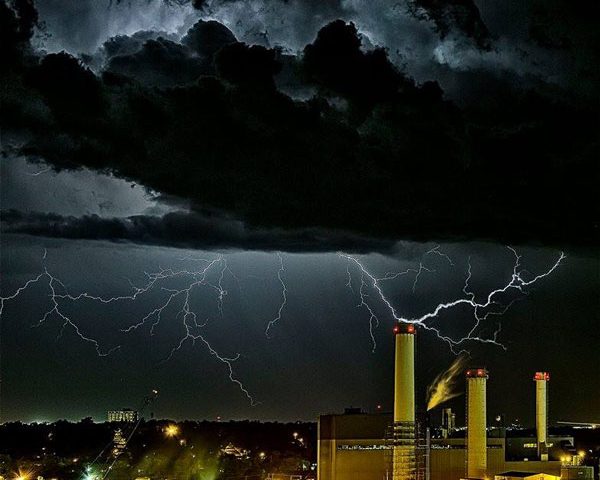- We Prevent Lightning Related Problems.

Lightning Protection: Towers Everywhere!
November 3, 2014
Lightning Protection: TANKS! Grounding Alone is not enough!
November 20, 2014Lightning Protection: Lightning 101 and Beyond

Drake Power Plant, Colorado Springs, CO USA- Larry Marr
Lightning Protection Blog
Week 101 | November 13, 2014
“And now, for something completely different”
Over the past few months I have been asked by several companies and other sites to write a blog which covers the basics on lightning and lightning protection. It took me a while, but I do believe that I have been able to come up with a simple way to introduce the audience to the basics and give you all the information that you need to get started on contemplating Mother Nature’s dynamite.
In this blog, I review the basics of lightning, and include links and papers which will assist you in understanding how lightning works, the threat that it represents and the steps you should be implementing in order to preserve your assets, protect your employees and maintain safety and sustainability for your company.
In addition, I will cover the different types of lightning protection available, as well as losses and consequences of not having lightning protection. I will not go through every industry, but just a few as examples (Tank Storage and Power Generation). But it is important to note that there is no industry that has not been impacted severely by a lightning strike and/or the secondary effects of lightning.
However, the “different” part is that I will letting another company host my blog and just posting the introduction here. Over the next few months I will be doing this from time to time. I was amazed at how many people felt that their audience needed a primer on lightning and am truly happy to provide it. So this week, I am happy to share the Lightning Protection Blog with Thorne & Derrick in the United Kingdom
Included will be information on Lightning, Lightning Protection and Lightning, as a weather event and the future it holds.
- About Lightning: How does lightning work?
- The Cost of a Strike: Review the potential damages, losses and consequences of not having lightning protection
- Collection vs. Prevention: The different types of Lightning Protection
- What do I need to move forward?
Lightning 101: Principles of Cloud-to-Ground Lightning
Lightning is caused by the build-up of static electricity within a thundercloud. Negative charge accumulates on the bottom of the cloud and induces an equal positive charge on the surface of the earth. When the potential between the cloud and ground reaches about a billion volts, a downward leader begins to move from the cloud towards the earth. When the downward leader gets to about 200 meters from the earth, upward streamers are launched from the earth towards the downward leader. When the downward leader connects with an upward streamer, then the visible lightning strike is formed and massive current flows between the cloud and earth. A more extensive overview of lightning is offered in our paper “Preventing Direct Lightning Strikes by R. Carpenter, P. Carpenter & D. Sletten – March 2014”. To read more visit: http://www.cablejoints.co.uk/blog/article/lightning-protection-requirements
If you have any lightning stories you would like to share with us, positive or negative and/or if you have any questions or need additional information please feel free to contact me at LightningDiva@lecglobal.com
Be careful out there! Visit www.lightningprotection.com for all your lightning protection needs. Follow us on Twitter, Facebook and LinkedIn for more information and updates as well as some great photos. Thank you for visiting! Big thank you to Thorne & Derrick for hosting my blog this week.

